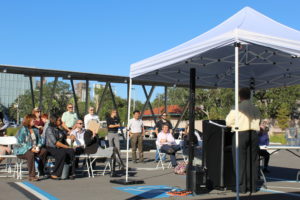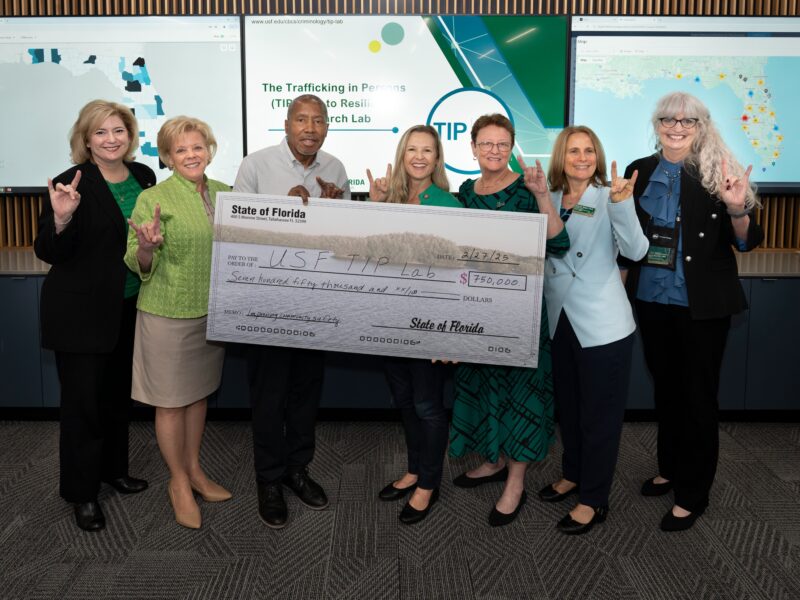Sustainability on campus just got a whole lot brighter.
The university unveiled a 40 kilowatt solar array carport on Wednesday during a ribbon cutting ceremony which saw speakers praise sustainable initiatives on campus.
The array, which was done in partnership with Duke Energy Florida and was funded by the Student Green Energy Fund, is projected to power about 15 percent of the new biology and chemistry labs on campus. It is just north of USF St. Petersburg’s biology and chemistry labs on Fourth Street South between Eighth and Ninth Streets.
“Spearheaded by an active student body and faculty, USFSP is investing in solar panels and energy efficient buildings, leading innovative research in sustainability and incorporating environmental stewardship into many planning decisions on campus,” said Martin Tadlock, interim regional chancellor.
The project is considered by some to be a major step in the university’s climate action plan, which aims to reduce baseline greenhouse gas emissions by 50 percent by 2035 — with the ultimate goal of achieving carbon neutrality by 2050.
Tadlock credits Sustainability Planner Brian Pullen for much of the progress in this department.
“The university took a major step in its sustainability efforts nearly two years ago by hiring Brian, its first full-time sustainability planner,” Tadlock said. “Brian works to ensure environmentally-friendly practices are used in operations, and to facilitate partnerships with the local community on projects such as this one.”
One such partnership has been Duke Energy Florida, which has had a major role in these initiatives on campus.
Tom Lawery, wholesale renewables manager for Duke Energy Florida, was one of the speakers at Wednesday’s event.
“I applaud the effort it took to get this facility built. The university students are the first to get credit for setting a direction and sticking to it, as it’s not easy getting a project from a vision to complete,” he said.
“I also thank the USFSP administration for leading, aiding and mentoring the project to completion as the next step toward the great sustainability goals,” Lawery said.

In 2014 the company awarded the university with a $1 million dollar grant to fund research on storing solar energy in new battery systems. In addition to the research, the grant resulted in a 6,600-square-foot, 100-kilowatt solar array that now sits atop the parking garage.
As far as Tadlock is concerned, the green initiatives have been paying off. “All the good work is beginning to show,” he said.
Earlier this year, USF St. Petersburg made The Princeton Review’s “Guide to 375 Green Colleges” for the first time. According to its website, the annual list “highlights colleges with the most exceptional commitments to sustainability based on academic offerings and career preparation for students.”
Each school is given a “green rating” from 80 to 99 based on data points that assess things such as whether or not a school has a sustainability committee and what percentage of a school’s food budget is spent on local and organic food. USFSP received a score of 95.
Also highlighted at the ceremony was the university’s recent recognition by the Association for the Advancement for Sustainability in Higher Education and the fact that the campus moved up 66 spots in the Sierra Club’s “Cool Schools” rankings, from 112 to 227.
Alana Todd, a senior double majoring in environmental science and anthropology, was also featured as a speaker at the event as a student sustainability representative. She and Tadlock turned on the solar array at the end of the ceremony.
As far as Lawery is concerned, students like Todd are the future of sustainability.
“The future of energy development lies in the capable hands of the next generation and having tangible results such as this project push all of us to do more toward real change,” Lawery said.
Above photo caption: Tadlock and Todd switch on the 40 kilowatt solar array that is projected to power about 15 percent of the new biology and chemistry labs on campus. Timothy Fanning| The Crow’s Nest



